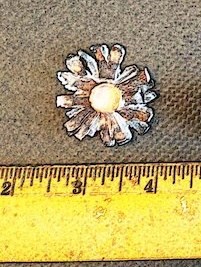Experts are often asked what kind of entrance and exit wounds are produced by various types of ammunition. The rounds (bullets) in the photograph below are hollow point rounds similar in design to those fired from the pistol pictured above. This is what they look like before they’re fired.
They’re about the diameter of a Sharpie pen, and that’s darn close to the size of most entrance wounds caused by these rounds—the size of the bullet. However, the angle of impact could alter the size and shape of an entrance wound.
Before moving on and to help set the stage for the rest of this brief article, click on the video/song below.
By the way, a photo of a gunshot wound appears below. If this is something you’d rather not see then please stop here. Otherwise, well, BANG, BANG!
Pictured below is an entrance wound to the chest. The puncture was caused by 9mm round at point blank range, a close contact gunshot wound. Obviously, this was a fatal wound since I took this picture during the autopsy of the victim. Note the post-autopsy stitching of the “Y” incision (above right of the photo).
Also notice the charred flesh around the wound. This was caused by the heat of the round as it contacted the victim’s skin. The bruising around the wound was, of course, caused by the impact when the bullet struck the victim.

To illustrate how a bullet fragments and expands when hitting a solid surface, including bone, we fired a round directly into the range wall. Keep in mind, this was a controlled experiment conducted by professionals inside a facility designed for such testing. Please DO NOT try this yourself. Again, DO NOT point any weapon at any object you do not intend to shoot. When at a firing range ALWAYS point weapons downrange at designated targets.
The next picture is of a round after it was fired from a distance of two-feet directly into the wall inside the specially-designed firing range (see top photo). The round passed through the self-healing wall tiles, striking the concrete and steel wall on the the other side. Hitting the solid surface head-on caused the bullet to expand and fracture into a daisy-like shape, a result that often creates the large and flesh-torn exit wounds we sometimes see in shooting victims.

Below are other rounds we recovered after they’s struck hard surfaces at various angles. All were fired from the same gun. The bullet at the far right was fired directly into a massively thick pile of foam rubber. It maintained its shape. The object at the top of the photo is an ejected brass casing.

Once inside the body, bullet slivers/fragments can break away from their base (shrapnel) causing further internal damage. The size of an exit wound depends upon what, if anything, the bullet hits while inside the body. If the bullet strikes only soft tissue the wound will likely be less traumatic unless, of course, it compromises a major blood vessel. If it hits bone, expect much more damage.

Easy rule of thumb—the larger the caliber (bullet size), the bigger the hole.
Bullets that hit something other than their intended target, such as a brick wall or a metal lamp post, could break apart and send pieces of flying copper and lead fragments into crowds of innocent bystanders. Those flying fragments basically become smaller bullets and are just as lethal as any intact, full-sized bullet.
FYI – Bullets don’t always stop people, nor do they always kill. I’ve seen shooting victims get up and run after they’d been shot several times.
Bullets Don’t Always Kill: Sometimes being shot does no more than to make the person really mad, so LOOKOUT!
Always keep Sir Isaac Newton’s Third Law of Motion in mind when writing shooting scenes. “The size of the force on the first object must equal the size of the force on the second object—force always comes in pairs.”
Therefore, if the blast is enough to send a victim flying backward through a door, then the same force is there in reverse and your shooter would also fly backward through the opposite door. Therefore, when the police arrive at the scene they’d find a person-size holes in each door and two unconscious people, one in the backyard and one in the front.
So that’s a big NO! People don’t fly twenty feet backward after they’ve been struck by a bullet or shotgun blast. They just fall down and bleed. They may even moan a lot. That’s if they don’t get back up and start shooting again. Simply because a suspect has been shot once or twice does not mean his ability, or desire, to kill the officer is over. This is why police officers are taught to shoot until the threat is over.



